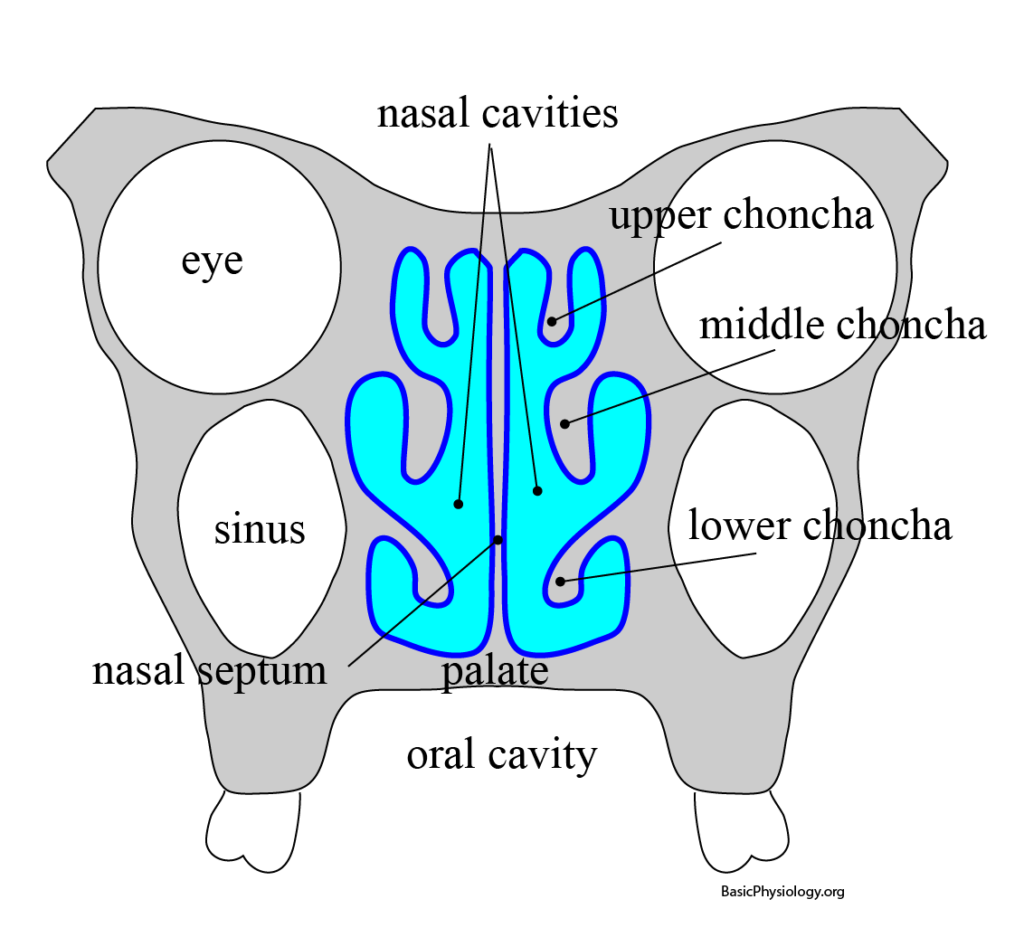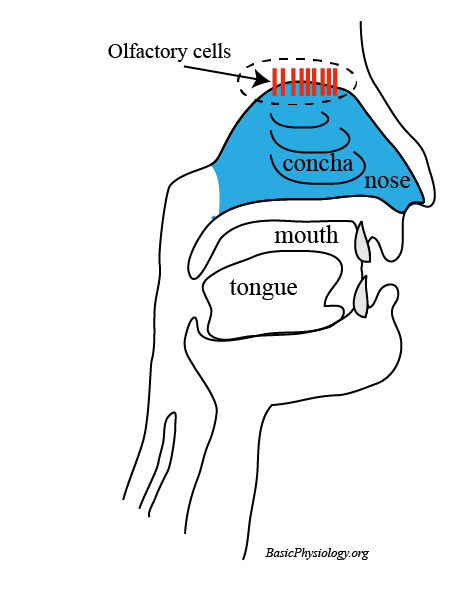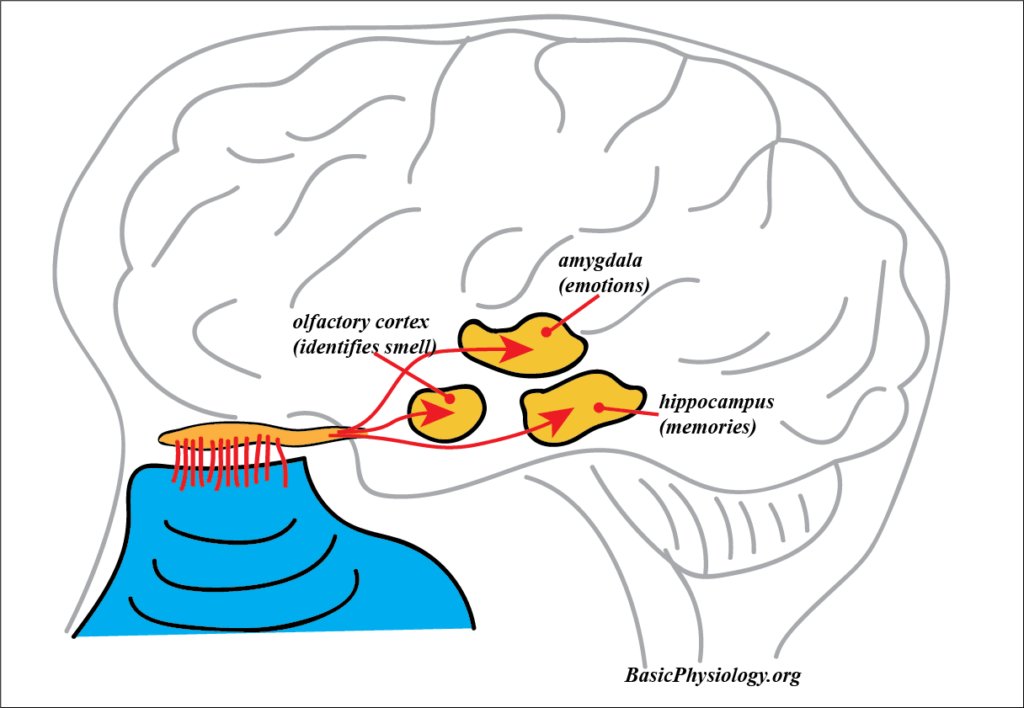Page Links:
A. Nose (copied from C.2. Upper Respiratory Airways):
1.
As air flows into the body, during inspiration, it flows through the following structures:
- nasal cavity
- oral cavity
- pharynx
- larynx
- trachea
- bronchial tree
2.
During the inspiration, the inspired air is modified as follows:
- The airways clean the air from large particles (larger than 4 micron).
- The air is humidified (makes it ‘wet’)
The temperature of the air is increased to body temperature.
3.
During inspiration, the airflow becomes very turbulent. This is due to structures in the nasal cavity such as the concha, which obstructs and diverts the air flow.
4.
This is good because this turbulence causes close contact between the air and the mucosa that lines the wall of the nose, mouth etc. thereby trapping large particles.
1. The nasal cavity, from the nostrils to the nasopharynx, consists of two cavities (in blue), left and right, divided by a nasal septum. It is separated from the mouth by the palate (= palatum).
|
2.
The nose has three conchae’s (upper, middle and lower) in each cavity. These structures help in increasing the mucosal surface and in creating air turbulence, which also increases the chances of detecting a smell.

1.
The olfactory (= smell) membrane or epithelium is located in the superior part of the nose.
2.
The area covered is about 2-3 cm2 in each nose and contains millions of sensors.
3.
The sensors are actually nerve cells! They have a bipolar shape.
4.
At one end, there are numerous olfactory hairs = cilia) sticking out into the mucus of the nose.
5.
At the other end of the olfactory cells, non-myelinated axons, that run through openings of the cribriform plate, into the overlying olfactory bulb.
6.
Essentially, these axons run through the base of the skull into the brain!
7.
8.
This is probably the only known situation in which nerve cells (as the olfactory cells really are) are renewed. All other nerve cells cannot do so.
9.
10.
We should also mention that in the olfactory epithelium there are also olfactory glands (= Bowman’s gland), which makes the mucus.
11.
This mucus is very important because it ‘catches’ and contains the chemicals from the air that will stimulate the cilia of the olfactory cells.
1.
The odours that we smell are actually chemicals floating in the air that stick to the mucus and dissolves in it.
2.
Therefore, we can only smell chemicals that are volatile. It also helps if the chemical is also water-soluble.
3.
4.
5.
The influx of sodium ions will depolarize the olfactory cell and if that reaches threshold, will induce one or more action potentials. If the smell is strong, there will be more action potentials.
6.
As the olfactory cell is actually a nerve cell, the action potential will propagate along the un-myelinated axon towards the olfactory bulb.
1.
As with taste, scientists have and are searching for the basic components of smell.
2.
One attempt, based on psychological studies, came up with the following list of smells:
3.
- Camphoraceous
- Musky
- Floral
- Pepper minty
- Ethereal
- Pungent
- Putrid
4.
Biochemical and gene studies are starting to show that there are hundreds if not thousands of primary smells.
5.
Also important is the fact that the threshold for smell is VERY low. Some compounds can be detected at extreme low concentrations (just a few molecules in 1 mml air!).
6.
Finally, the olfactory cells will also adapt to a stimulus. This occurs already in the first few seconds. There is a second adaptation but that occurs in the brain.
1.
The olfactory bulb contains glomeruli, in which thousands of axons from the olfactory cells synapse to.
2.
In addition, there are other nerve cells, such as the mitral cells that receive the axons from the olfactory cells.
3.
4.
The olfactory bulb and the olfactory tract together form cranial nerve I (= the first nerve). Further on in the brain, the tract divides into several parts.
5.
6.
Another tract connects to the hippocampus area (which stores the smell memories!)
7.
Other fibres go to the amygdala region. This area is important because there the smell stimuli are associated with emotions!
1.
Anosmia is when you cannot smell. Other names are hyposmia (= less sensitive), dysosmia (= distorted smell) and hyperosmia (= increased sensitivity).
2.
Anosmia (= no smell at all!) may happen following a trauma to the head.
3.
In that case, the axons from the olfactory cells that run through the cribriform plate to the olfactory bulbs, have been broken. This is (unfortunately) irreversible!
4.
5.
It is also interesting that taste is so much dependent on smell. If there is no smell, then food becomes much less tasty.
6.




